Akka Arrh (Arcade Review – Atari 50)
April 29, 2024 1 Comment
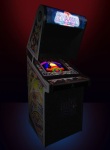 Akka Arrh
Akka Arrh
Platform: Arcade
Year: 1982
Unreleased Prototype (Compilation Debut)
Designed by Dave Ralston & Mike Hally
Included in Atari 50
Includes Dip Switch Options? No
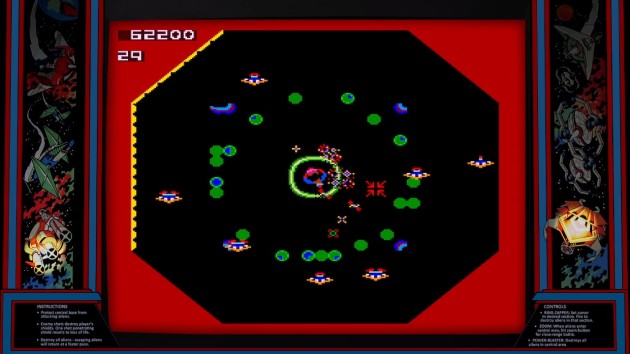
If you glanced at screenshots, it looks kind of like Robotron. This doesn’t even share the same DNA.
This was meant to be in Atari 50: The Definitive Review – Part Two but I had a lot to say about Akka Arrh, so it’s getting its own review. And yes, I’ll do the Jeff Minter remake sometime soon.
Apparently the victim of a poor reception in route testing, Akka Arrh made its retro collection debut with Atari 50. The whole situation with it reminds me of one of those stories you hear about a baby being abandoned, only to tearfully reunite with their biological family years later when they’re all grown-up with a family of their own. After four decades of all but pretending like this never happened, it finally feels like Akka Arrh was welcomed into the Atari family with open arms. It even got a widely-promoted remake led by certifiable legend Jeff Minter. That type of fairy tale ending almost never happens with cancelled games, but it does beg the question: were those players who tested Akka Arrh in 1982 the real villains or did they get it right all along? A little of both, actually.
The idea is you’re a turret in the center of a series of zones that gets bombarded by waves of enemies. In the larger overhead shot, you have a chance to wipe out entire sections of the swarm by bombing the segment they’re in. If any get through, you have to zoom in to defend your turret directly. Atari 50’s menu says that Akka Arrh borrows gameplay elements from Missile Command, but really, the similarities end with the game’s use of trackball-controlled crosshairs. Also, if you’re on consoles, sorry, but you have to use standard controls, though they work fine, really. The camera is NOT automatic and it’s up to you when you change views. It takes a LOT of getting used to, and at first, I didn’t like Akka Arrh. It’s not intuitive like the best coin-ops of this era are. You almost have to rewire your brain for this specific play style. Once you do, it’s actually not a bad little game at all. Easily the best part is how the overhead combat works. In the overhead view, the entire section that your crosshairs are currently aimed at is highlighted. You don’t have to aim directly at the clusters of enemies. A single shot on any part of the currently highlighted area kills every enemy within. And it’s AWESOME!
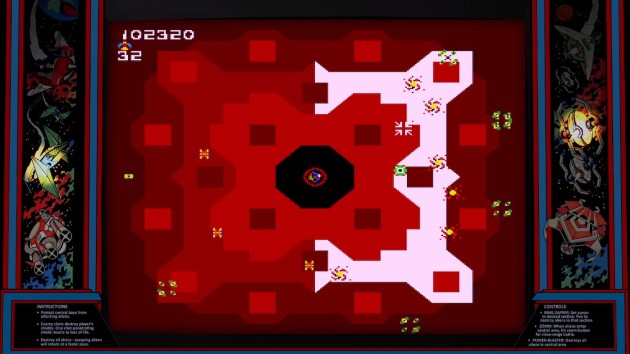
As you get deeper into the game, some of the overhead patterns get downright ridiculous (not to mention confusing), and it lessens the potential for those oh-so-satisfying big shots. It’s still a lot of fun, though.
So, half of Akka Arrh is really fun and so incredibly satisfying that it’s almost unbelievable that it didn’t get released. Then you get to the close-up view of the turret, where you have a standard gun, and you’re stuck with gameplay that just isn’t very fun. Despite the fact that your bullets don’t stop at the crosshairs, you do need to actually aim the crosshairs on the enemies in order to kill them. Total bullsh*t! The problem is the enemies are too fast and often move too erratically, no matter how fast or slow you set the crosshair in the options. Even worse is that there’s no pizzazz to the turret part of the game. The enemies are very generic, and they don’t have satisfying POPS to them when you successfully shoot them. At least with the overhead part, you get a rush when you hit a big wave. The turret has none of that charm. Even if you zoom in to watch yourself use your once-per-level center-clearing bomb, it doesn’t feel like you accomplished anything. For such a beautiful game, it somehow has NO personality, and that’s just weird for this era of Atari.
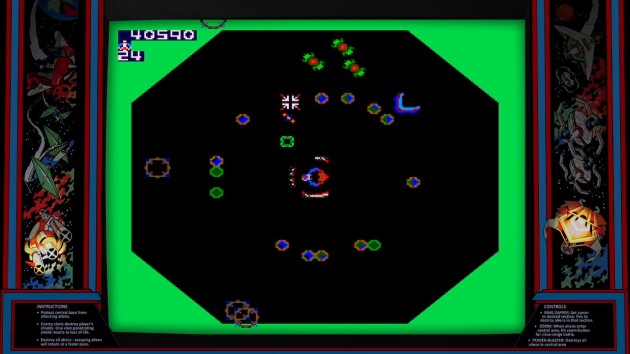
I think a lot of the problems with Akka Arrh could have been fixed if the shields placed by the enemies weren’t as spongy as they are. The enemy patterns are hard enough without them hiding behind what can become a lot of shields.
But, do you know what’s even odder? For whatever reason, Akka Arrh’s close-up gameplay just didn’t feel as intense as the stakes seem to dictate it should. The turret is protected by a shield that enemies have to ping their way through. When that becomes heavily damaged, you should be sweating every time baddies make it through your initial volley of shots in the overhead view, but you don’t. It’s just not exciting at all, and this is one of those times where I don’t have a satisfactory theory on why that is. Maybe it’s because the warning noise is this underwhelming “boop boop boop” sound, or maybe it’s because the game quickly becomes too overwhelming to the point of hopelessness, or maybe it’s just because the enemies are so bland that they don’t command a sense of urgency. More than likely, it’s all the above. Another issue is that when the turret playfield is full of enemy shields, just recognizing the enemies becomes a challenge. They don’t stand out very well. Robotron: 2084 proved you can spam the screen with things and still be able to tell specific characters and enemies apart. Here, it just all bleeds together. It’s one of the most visually noisy games of this era.
Akka Arrh is that rare game that’s lesser than the sum of its parts. But, that ultimate sum is still pretty fun. Once you get the hang of it, Akka Arrh feels like it manages to succeed despite itself. The scoring is well handled, with further away zones in the overhead view scoring more points, but at the cost of a small-but-pronounced delay in when you can fire your next shot. This opens the gameplay up to allow players to come up with their own strategies, and I’m all about that with arcade shooters. Further enhancing the risk/reward gameplay is the fact that you score the most points in the significantly harder and more dangerous turret view. If you’re feeling brave, you can allow the enemies to reach the core and pick them off there for 4x the points. There’s also the timing factor, as you’re given one bomb per level that can be used to bail you out and clear the core if too many enemies reach the center. When and why to use that bomb is up to you. Even better is you don’t have to zoom in to use it. The only downside is you can’t bank unused bombs. They got around the logic of this by calling it a “power blaster” that recharges between levels, implying that it has a max charge. Hey, this is war! Get some more batteries or something!
Each level has a different layout on the surface and consists of three waves of enemies. The third wave is always made-up of enemies who, instead of attacking the turret, drop things around the turret that eventually clog-up the playfield and make it more difficult to shoot the baddies who aggressively attack. Once again Akka Arrh presents a perfect risk/reward scenario. So, what do you do? Kill the attackers with the bomb, or kill the things that aid the defense of the attackers in later rounds? In terms of raw gameplay, Akka Arrh is deceptively deep. Really, I just wish the core turret gameplay was a lot more fun than it is. The really heartbreaking thing is something as small as increasing the size of the enemies or the size of your bullets could have made this a lot more fun. Sure, it’s frustrating when the enemies straddle the dividing line of the barriers on the surface, but there’s some genuinely fun and amazing ideas at play here. It took a lot of time, but once I got the hang of Akka Arrh, I couldn’t put it down. What was supposed to be one final hour long play test before I wrote the review turned into the best six hours I spent with Akka Arrh. It just finally worked for me.
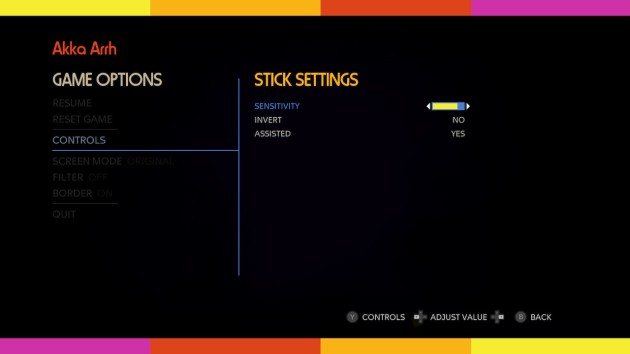
Normally, Akka Arrh would use a trackball, and if you’re playing on PC, that’s still an option. If you’re on consoles, you’re going to want to adjust the sensitivity of your analog sticks, as the default is just not fast enough for the gameplay. I found moving the slider to where I have it in this screenshot worked best for me. Fast enough to react to most enemies, but still accurate enough to not overshoot your targets. I also highly recommend that players experiment with ASSISTED toggled both on and off. When it’s on, your movement is automatically slowed down while you’re actively shooting. My Dad preferred it on. I easily had my best games with it turned off. The best thing I can say about Atari 50 is that they loaded every imaginable controller option.
At the same time, I totally get why this wouldn’t have been a hit in 1982. The learning curve is one of the steepest of any coin-op shooter I’ve seen. Everything that makes for great arcade gameplay is here, except the instant gratification. It takes a while to figure out when to switch views, and why you would. On top of that, learning the enemy patterns and getting a feel for the game’s flow takes longer than normal because everything is so damn generic looking. It doesn’t help that the two styles of graphics, for the overworld and the turret, look nothing alike. You’d swear this is two games combined into one. It sort of is! For players weaned on Asteroids, Space Invaders, Carnival, King & Balloon, etc, I imagine Akka Arrh was like the difference between driving a truck and driving a tank. Despite what the menu in Atari 50 says, Akka Arrh isn’t really all that much like Missile Command, or any other game from this era. It’s a one-off. While I ultimately did find the fun in Akka Arrh, it took me multiple play sessions over the course of sixteen months to get to that point. I guess that best answers the question of why Akka Arrh failed in route testing.
Verdict: YES!
$39.99 couldn’t get that episode of Dinosaurs out of her head in the making of this review. “Akka Arrh I’m dying you idiots!”

Oh wow. This is super neat. Whoa. I just played Akka Ahrr (2023) and had some reflective thoughts on it, but it completely evaded the knowledge of this version’s existence nor its availability in Atari 50. This is what I get for starting with Llamasoft: The Jeff Minter Story and not starting at the natural origin of Digital Eclipse’s interactive docuseries. I guess I’ll have to go back and work my way back to this. Thanks for sharing your review. It caught my eye.